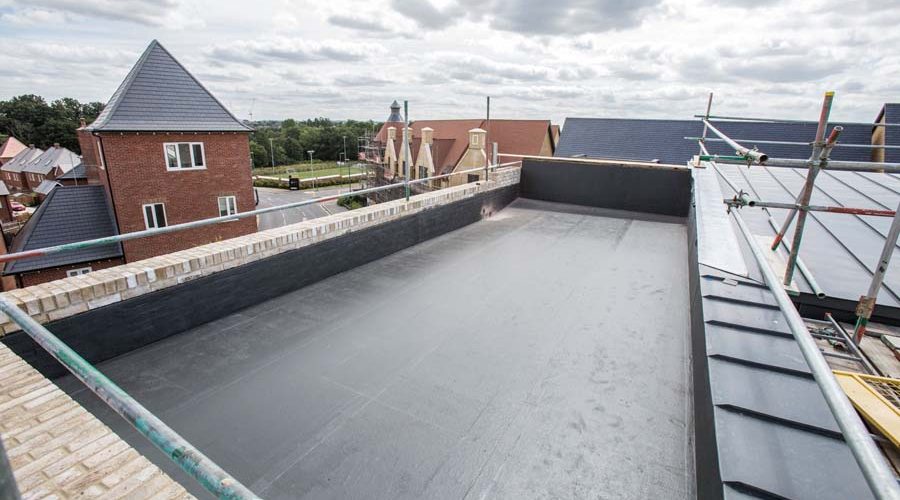Victoria Ramwell from Kemper System explains why cold-applied liquid waterproofing can offer a durable solution for social housing projects.
Kemper System
When considering product specification for flat roof refurbishment or new-build projects on a social housing complex, streamlined planning is vital to ensure budget and time constraints are adhered to.
For many contractors working in collaboration with a county council, certain design elements will need to be taken into consideration during specification. This is because many projects will need to accommodate a high number of residents in-situ during repair works; for example, so it’s important to devise a strategy that is careful to avoid any unnecessary disturbance without compromising the specification of products or installation quality.
Quick, easy application and a system that will stand the test of time are also key elements to consider. This is why, in many cases, cold-applied liquid waterproofing is often the preferred choice for housing projects.
Why specify aliquid system?
It can be argued the most desirable benefits of using liquid waterproofing for housing projects is its versatility and durability, as well as quick and easy installation methods. Liquid waterproofing can be used in new-build or refurbishment projects, and offers a sound solution that can not only be installed on roofs but communal walkways, balconies and car parks – which reinforces its versatile qualities.
Cold-applied liquid installations are flame-free, meaning system applications do not require the use of hot works on site. This minimises the risk of any health and safety issues associated with products being applied using a blow torch or naked flame – especially beneficial for occupied housing blocks.
There are also quick-curing liquid products using PMMA technology on the market which can offer excellent membrane performance and facilitates shorter contract possession times and fast project completion. However, polyurethane systems are probably the most popular and more widely used chemistry type as they are versatile materials that can be used in a multitude of applications.
Specifying a liquid also means contractors can easily tackle complex details within the differing roof designs such as outlets and penetrations. This cuts down time on site and ultimately reduces overall costs, ensuring a completely seamless finish which is fully bonded and compatible with most substrates.
Which liquid to specify?
Liquid waterproofing systems are made up of different chemistries, use alternative application techniques and have different curing times, meaning some are far better suited in certain applications than others. There are both wet-on-wet and wet-on-dry systems available and when specified from a manufacturer with appropriate BBA certification, should offer a durable waterproofing solution for the client and end-user alike.
If specifying a liquid system, take the time to research which one is most suitable for your project. Consider requirements such as compliance with Building Regulations; for example, fire resistance, or specific performance characteristics, including the compatibility of the surfaces to be waterproofed, ability to withstand substrate movement, and resistance to damage from anticipated load levels or trafficking.
Independent product accreditation is used to effectively communicate suitability, so it is advisable to research the manufacturer’s current product certification.
Installation benefits
Carrying out refurbishment works with minimum disruption while keeping costs down is key, especially in housing projects where residents will prefer to remain in their homes and having the premises empty is just not an option. Using a liquid waterproofing system means the contractor can be on and off site in the minimum amount of time, whilst avoiding the additional costs of temporary walkways and access arrangements.
Large expanses of sheeting materials on a roof area are not practical in many housing refurbishments and could offer health and safety issues depending on the location of the site. High-rise housing apartments; for example, could be subject to high winds on the roof area, and access to the roof could be restricted or unsafe for operatives that might be carrying lots of materials.
No hot works are required as part of cold-applied liquid waterproofing systems, further reducing potential health and safety risks, and with Kemper System; for example, there are no wait times between applications of resin. And because it is seamless, once cured, the system forms an elastomeric waterproof membrane that cannot delaminate, is UV stable and creates a sturdy bond directly to the substrate.
Peace of mind
Sustainable refurbishment, or new-build homes, are a key element to decision-making for local councils and housing associations. When specifying any building material, how can they ensure the buildings will provide a home for the future?
Building designs, and the products specified to use within a refurbishment or new complex, must offer a durable, long-term solution, as well as address the immediate challenges on site.
There are many benefits of choosing a cold-applied liquid waterproofing system for flat roof repairs, and with quality application, this can ensure a sustainable refurbishment to serve a community for many years to come.
We must be aware of specification switching, which can often happen during housing projects because of budget or time constraints. Maintaining the specification on a project is often difficult, yet, the implications of not doing so can cause a single product or even an entire system to fail – therefore, raising liability issues.
It is always advisable to liaise with a trusted product manufacturer and sector associations for advice. Kemper System; for example, has a dedicated technical team to offer bespoke guidance on each individual project – as well as product training for operatives.









